Using sensory rooms can be a great way to help students stay regulated throughout the school day. There is no shortage of awesome equipment and activities that can be found in a sensory room, however, there is not a one-size-fits-all approach to sensory regulation and therefore when implementing a sensory room it is important to be mindful of the type of input a student needs and what equipment or activity should be used to provide that input. This includes whether the student would benefit from active sensory input or passive sensory input. Today's Regulation Rendezvous will examine both types of sensory rooms.
Active Sensory Rooms
Active sensory rooms are great for students who are described as being in constant motion and benefit from actively engaging with the environment. Also, students who need alerted may need active input to regulate.
Active Tactile Activities
In an active sensory room, you may provide students with activities or equipment to explore tactilely such as fidgets, sensory walls, or a ball pit.
 |
Beavertown Elementary, Kettering
|
 |
| Trotwood ELC, Trotwood |
 |
| Rosa Parks ELC, Dayton |
 |
Trotwood ELC, Trotwood
|
 |
| Perrin Woods Elementary, Springfield |
Active Proprioceptive Activities
Proprioceptive input is always calming. Actively engaging in proprioceptive input can help the student activate their joints, contract their muscles, and better gauge the pressure they receive. Possible active proprioceptive activities include exercise equipment, heavy work jobs, or other equipment such as body socks or a steamroller machine.
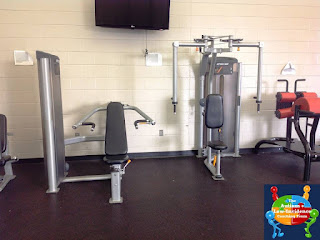 |
| Wayne High School, Huber Heights |
 |
| Mound Elementary, Miamisburg |
 |
| Learning Center- East, MCESC |
 |
| Stevenson Elementary, Mad River |
 |
| Trotwood ELC, Trotwood |
Active Vestibular Activities
There are a variety of ways for students to get active vestibular input. Keep in mind that rhythmic, linear vestibular input is calming while erratic, rotational vestibular input can be alerting. Active vestibular activities include:
swings,
 |
| Helke Elementary, Vandalia |
 |
| Perrin Woods Elementary, Springfield |
yoga, S'cool Moves, or movement exercises,
 |
| Stevenson Elementary, Mad River |
 |
Amy Beanblossom
Arcanum Butler Elementary, Arcanum |
 |
Tracey Cooper
Tecumseh Elementary, Tecumseh
|
circuits or sensory paths,
 |
Deanna Hicks and Team
East Elementary, Eaton |
exercise equipment,
 |
Mad River Middle School, Mad River
|
therapy ball bounces,
 |
Stevenson Elementary, Mad River
|
and rocking in a rocking chair.
 |
Stevenson Elementary, Mad River
|
Passive Sensory Rooms
Many of our students struggle with filtering out auditory, visual, and tactile input throughout the day. This may cause them to be on guard or easily overwhelmed. Time to relax without added stimuli or demands in a passive sensory room can allow them time to decompress and calm so they are more regulated and ready to learn.
Passive Proprioceptive Activities
There are a variety of comfortable, proprioceptive seating options that provide students with calming input. Adding weighted supports such as a weighted blanket, lap pad, or stuffed animal can maximize the calming impact.
 |
Stevenson Elementary, Mad River
|
 |
Wendy Sondergaard
Rushmore Elementary, Huber Heights |
 |
Jackie Vollmer
Driscoll Elementary, Centerville |
 |
Amy Pratt
Springcreek Primary, Piqua
|
 |
| Smith Elementary, Oakwood |
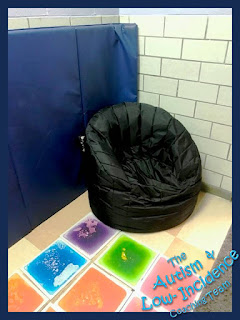 |
| Demmitt Elementary, Vandalia |
Some students may want to lay on the floor with a weighted blanket, be massaged with a sensory roller, or rolled up in a sheet to provide passive proprioceptive input.
 |
Keelin DiMuccio
Fairbrook Elementary, Beavercreek |
Passive Visual Activities
Dimmed lighting can really limit the overwhelming stimuli often resulting from overhead fluorescent lighting. Some passive sensory rooms use special lighting from projectors, bubble tubes, or fiber optic strands.
 |
Athenia Eversole
Versailles Elementary, Versailles |
 |
Karyn Smith
Tri-Village High School, Tri-Village |
 |
Allysson Leapley
Tipp High School, Tipp City |
 |
| Horace Mann Elementary, Springfield |
In some instances, smaller areas such as a tent or fiber optic tunnel can further filter out visual stimuli.
 |
| Demmitt Elementary, Vandalia |
 |
| Trotwood ELC, Trotwood |
Passive Auditory Activities
Schools are naturally auditory-rich environments from staff instructing and redirecting, students chatting, and environmental and hallway noise. This can be especially overwhelming for students who have a low threshold for auditory input. Passive sensory rooms should be a very quiet environment. At times this may require noise dampening or sound-proofing the room. It may also require students to wear noise-cancelling headphones, headphones with soft music, or playing calming background music.
 |
Angie Kleinhans
Stebbins High School, Mad River
|
 |
Granville Bastin
Preble ESC Classroom |
Combined Passive and Active Sensory Rooms
Space is often limited within the school building so having two separate locations for passive and active sensory rooms is not always a realistic option. With some increased planning and organization, these needs can easily be met within the same location.
 |
| Kettering Fairmont High School, Kettering |
 |
| Springfield High School, Springfield |
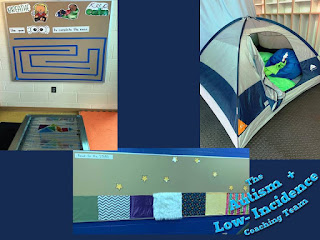 |
Tracey Cooper
Tecumseh Elementary, Clark ESC |
When scheduling time in the combined sensory room, you will need to monitor when students who need calming, passive input are present vs. those who need more active input use the room.
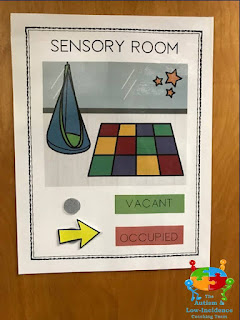 |
| Helke Elementary, Vandalia |
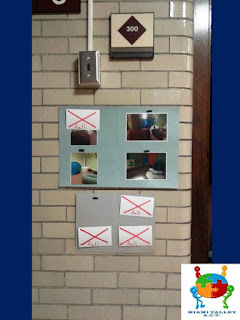 |
| Smith Elementary, Oakwood |
Additionally, we recommend clearly defining the equipment within the space so that staff and students know how each sensory activity or equipment may impact the student. Use visual supports to help organize what the student does within the room to make sure they get the input they will benefit from.
 |
Lori Stemmer
Springfield High School, Springfield
|
JFK Elementary, Kettering
 |
| Kettering Middle School, Kettering |
For more information about keeping students regulated while at school, check out our previous Regulation Rendezvous posts:









































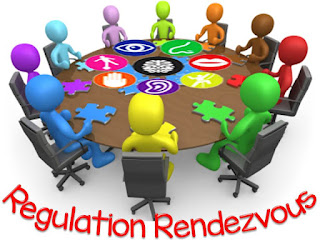







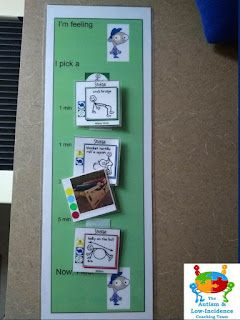
No comments:
Post a Comment